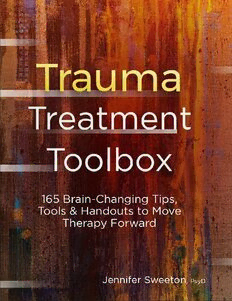
Trauma Treatment Toolbox: 165 Brain-Changing Tips, Tools & Handouts to Move Therapy Forward PDF
Preview Trauma Treatment Toolbox: 165 Brain-Changing Tips, Tools & Handouts to Move Therapy Forward
Trauma Treatment Toolbox 165 Brain-Changing Tips, Tools & Handouts to Move Therapy Forward Jennifer Sweeton, PsyD Copyright © 2019 Jennifer Sweeton Published by PESI Publishing & Media PESI, Inc. 3839 White Ave Eau Claire, WI 54703 Cover Design: Amy Rubenzer Editing: Donald Altman Layout: Bookmasters & Amy Rubenzer Proudly printed in the United States of America ISBN: 9781683731795 All rights reserved PESI Publishing & Media pesipublishing.com About the Author Dr. Jennifer Sweeton is a licensed clinical psychologist and internationally-recognized expert on anxiety and trauma, women’s issues, and the neuroscience of mental health. She completed her doctoral training at the Stanford University School of Medicine, the Pacific Graduate School of Psychology, and the National Center for PTSD. Additionally, she holds a master’s degree in affective neuroscience from Stanford University, and studied behavioral genetics at Harvard University. Dr. Sweeton resides in the greater Kansas City area, where she owns a group private practice, Kansas City Mental Health Associates. She formerly served as the President of the Oklahoma Psychological Association, and holds adjunct faculty appointments at the University of Kansas School of Medicine and the University of Oklahoma Health Sciences Center. She is the current President-Elect of the Greater Kansas City Psychological Association. Dr. Sweeton offers psychological services to clients in Oklahoma, Kansas, and is a sought-after trauma and neuroscience expert who has trained thousands of mental health professionals in her workshops. This book is dedicated to my daughter, Annaliese. May you always enjoy a strong, integrated, resilient brain! Table of Contents Introduction: How to Use This Workbook PART Brain Basics for Trauma Recovery I Chapter 1: The Neuroscience of Trauma Tool 1-1: Understanding the Amygdala Handout: Amygdala: The Fear Center Tool 1-2: Understanding the Hippocampus Handout: Hippocampus: The Memory Center Tool 1-3: Understanding the Insula Handout: Insula: The Interoception Center Tool 1-4: Understanding the Prefrontal Cortex Handout: Prefrontal Cortex: The Thinking Center Tool 1-5: Understanding the Cingulate Handout: Cingulate: The Self-Regulation Center Tool 1-6: Understanding Brain Connectivity Chapter 2: Integrating Brain Change Approaches Tool 2-1: Bottom-Up Approaches to Brain Change Handout: Change the Brain Bottom-Up Tool 2-2: Your Brain on Bottom-Up Techniques Handout: Your Brain on Bottom-Up Techniques Tool 2-3: Top-Down Approaches to Brain Change Handout: Change the Brain Top-Down Tool 2-4: Your Brain on Top-Down Techniques Handout: Your Brain on Top-Down Techniques Tool 2-5: Roadmap for Treating Trauma Chapter 3: Pendulation and Titration Tool 3-1: The Distress Thermometer Handout: Distress Thermometer Worksheet Tool 3-2: Identifying Boiling and Freezing Points Handout: Your Boiling and Freezing Points Tool 3-3: Identifying Degrees of Freedom Handout: Your Degrees of Freedom Tool 3-4: Taking a Temperature Reading Handout: Taking Your Temperature Tool 3-5: Locating Distress in the Body Handout: Distress in Your Body Tool 3-6: Noticing Distress in the Mind Handout: Your Distressed Thoughts Tool 3-7: Pendulation Strategies Handout: Anger Induction Handout: Fear Induction Handout: Love Induction Handout: Happiness Induction Tool 3-8: How to Integrate Pendulation and Titration into Bottom-Up Techniques Handout: Using Bottom-Up Techniques to Manage Distress PART Bottom-Up Tools II Chapter 4: Focused Breathing Tools Tool 4-1: Breathe Through the Diaphragm Handout: Vagus Nerve Activation through the Breath Tool 4-2: The Brain on Focused Breathing Handout: Your Brain on Focused Breathing Tool 4-3: Diaphragmatic Breathing Handout: Diaphragmatic Breathing Tool 4-4: Ocean Breath Handout: Ocean Breath Tool 4-5: The Five-Count Breath Handout: The Five-Count Breath Tool 4-6: Balanced Brain Breath Handout: Balanced Brain Breath Tool 4-7: 5-5-8-2 Breath Handout: 5-5-8-2 Breath Tool 4-8: Body Breath Handout: Body Breath Script Tool 4-9: Moving Breath Handout: Moving Breath Tools 4-10: Other Ways to Activate the Vagus Nerve Handout: Ways to Activate the Vagus Nerve Tool 4-11: Power Breath Handout: Power Breath Chapter 5: Body-Based Tools Handout: What is Interoception? Handout: Your Brain on Interoceptive Exposure Tool 5-1: Anchoring into the Present Handout: Anchoring into the Present Tool 5-2: Other Ideas for Anchoring into the Present Handout: Other Ideas for Anchoring into the Present Tool 5-3: Sensory Sensitization Training Handout: Sensory Sensitization Training Tool 5-4: Breath Connection Handout: Breath Connection Script Tool 5-5: Heart Connection Handout: Heart Connection Script Tool 5-6: Find your Center Handout: Find your Center Tool 5-7: Scanning for Strength Handout: Scanning for Strength Script Tool 5-8: Tense and Release Handout: Tense and Release Tool 5-9: Conditioned Relaxation Handout: Conditioned Relaxation Tool 5-10: Autogenic Training Handout: Autogenic Training Tool 5-11: Integrated Systems Check Handout: Integrated Systems Check Chapter 6: Movement-Based Techniques and Poses Handout: What are Movement-Based Techniques? Handout: Your Brain on Movement-Based Techniques Tool 6-1: Incorporating Movement and Poses into Psychotherapy Handout: Incorporating Movement and Poses into Psychotherapy Handout: Example of Incorporating a Pose and Movement into a Top- Down Approach Tool 6-2: Trauma-Informed Instruction
